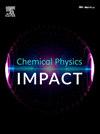Toxic gas whisperers: Sensing dynamics of pristine and alloyed Cu nanoclusters
IF 4.3
Q2 CHEMISTRY, PHYSICAL
引用次数: 0
Abstract
The present study investigates the interactions of environmental pollutants, such as CO, NO, and NH₃, with copper nanoclusters Cuₙ (n = 2–6), given their significant applications in catalysis and gas sensing. Among the nanoclusters studied, Cu₄ and Cu₆ demonstrated the strongest interactions with toxic gases and exhibited aromatic properties. When alloyed with silver (Ag) and nickel (Ni) to form bimetallic nanoclusters (Cu₃M and Cu₆M, where M = Ag, Ni), these clusters displayed enhanced catalytic activities for gas sensing, storage, and removal of harmful chemicals. The study calculated the structural stability, infrared activity, formation energy, and binding energies. Cu₄ and Cu₆ clusters substituted with Ag and Ni yields binding energy values of -2.82 eV, -3.26 eV, -3.32 eV, and -3.62 eV, respectively. These results indicate that interactions with transition metals (TMs) are energetically favorable. The calculated adsorption energies for CO gas on pristine Cu₄, Cu₃Ag, and Cu₃Ni were determined to be -0.60, -0.40, and -0.56 eV, respectively, indicating weak physisorption in the case of Cu₃Ag. Similarly, the adsorption energies for NO gas on Cu₄, Cu₆, and Cu₃Ag were -0.79, -0.21, and -0.77 eV, respectively. Furthermore, NH₃ adsorption on Cu₃Ag resulted in an energy of -1.11 eV, suggesting stronger interaction compared to other gases. The optimal adsorption energy obtained suggests promising recovery times for CO and NO on Cu₃Ni and Cu₆, measured at 2.20 and 2.70 s, respectively, underscoring their effectiveness in molecular sensing. For NH₃, the recovery time of 3.85 s highlights the potential of both doped and pristine clusters for efficient NH₃ removal from the environment. Additionally, the study analysed the density of states (DOS), revealing significant changes in molecular orbitals, particularly in the HOMO-LUMO gap, which further supports the enhanced reactivity of the nanoclusters.

有毒气体低语者:原始和合金铜纳米团簇的传感动力学
本研究调查了环境污染物,如CO, NO和NH₃,与铜纳米簇Cu (n = 2-6)的相互作用,考虑到它们在催化和气体传感方面的重要应用。在所研究的纳米团簇中,硫酸铜和₆与有毒气体的相互作用最强,并表现出芳香特性。当与银(Ag)和镍(Ni)合金化形成双金属纳米团簇(Cu₃M和Cu₆M,其中M = Ag, Ni)时,这些团簇在气体传感、储存和去除有害化学物质方面表现出增强的催化活性。研究计算了结构稳定性、红外活度、地层能和结合能。用Ag和Ni取代的硫酸铜和₆簇的结合能分别为-2.82 eV、-3.26 eV、-3.32 eV和-3.62 eV。这些结果表明与过渡金属(TMs)的相互作用在能量上是有利的。计算出的CO气体在原始Cu₄、Cu₃Ag和Cu₃Ni上的吸附能分别为-0.60、-0.40和-0.56 eV,表明Cu₃Ag的吸附力较弱。同样,Cu₄、Cu₆和Cu₃Ag对NO气体的吸附能分别为-0.79、-0.21和-0.77 eV。此外,NH₃吸附在Cu₃Ag上的能量为-1.11 eV,表明与其他气体相比,NH₃的相互作用更强。获得的最佳吸附能表明,Cu₃Ni和Cu₆对CO和NO的回收时间分别为2.20和2.70 s,表明其在分子传感方面的有效性。对于NH₃,3.85 s的恢复时间突出了掺杂簇和原始簇从环境中有效去除NH₃的潜力。此外,该研究分析了态密度(DOS),揭示了分子轨道的显著变化,特别是在HOMO-LUMO间隙,这进一步支持了纳米团簇的反应性增强。
本文章由计算机程序翻译,如有差异,请以英文原文为准。
求助全文
约1分钟内获得全文
求助全文
来源期刊

Chemical Physics Impact
Materials Science-Materials Science (miscellaneous)
CiteScore
2.60
自引率
0.00%
发文量
65
审稿时长
46 days
 求助内容:
求助内容: 应助结果提醒方式:
应助结果提醒方式:


